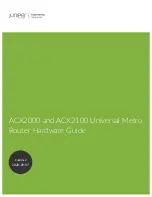
•
Do not remove installed components from the chassis.
•
Always disconnect all external cables before lifting or moving the chassis.
To prevent personal injury or damage to the chassis, never attempt to lift or tilt the chassis using the
handles on modules (such as power supplies, fans, or cards); these types of handles are not designed to
support the weight of the unit. Statement 1032
Warning
Tools and Equipment
You need the following tools and equipment to install and upgrade the router and its components:
•
ESD-preventive cord and wrist strap
•
Antistatic mat or antistatic foam
•
Number 1 and Number 2 Phillips-head screwdrivers
•
Flat-blade screwdrivers: Small 3/16-inch (0.476 cm) and medium 1/4-inch (0.625 cm):
◦
To install or remove modules
◦
To remove the cover if you are upgrading the memory or other components
•
#12-24 pan-head screws to secure the router to the equipment rack
•
Cables for connecting to the WAN and LAN ports (depending on the configuration)
For more information about cable specifications, see
.
Note
•
Ethernet hub, switch, or PC with a network interface card for connecting to the Ethernet ports
•
Console terminal (an ASCII terminal or a PC running terminal emulation software) that is configured
for 9600 baud, 8 data bits, no parity, and 2 stop bits
•
Console cable for connecting to the console port
•
(Optional) Modem for connecting to the auxiliary port for remote administrative access
•
Auxiliary cable for connecting to the auxiliary port (you can supply this cable or order one)
•
Ratcheting torque screwdriver with a Phillips head that exerts up to 30-pound force per square inch
(in-lb) or 0.02-kilograms force per square millimeter (kgf/mm2) of pressure
•
Crimping tool as specified by the ground lug manufacturer
•
Wire-stripping tools for stripping both 8-AWG and 12-AWG wires
•
Tape measure and level
Cisco ASR 902 and ASR 902U Aggregation Services Router Hardware Installation Guide
61
Preparing for Installation
Tools and Equipment
















































